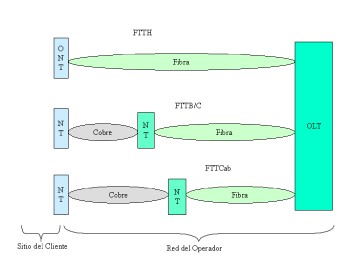|
Access Networks
General Features of Access
Wired access networks are fixed
networks in which the user connects via his or her
terminal at a particular geographical point at which
the service provider delivers a connection through a
wire. That access ďwireĒ may be made of copper
pairs, coaxial cable, or optical fiber.
Access nodes may be telephone
switchboards, remote phones, access concentrators,
DSLAMS (Digital Subscriber Line Access
Multiplexers), PON nodes, multiservice nodes,
switches, routers, or access gateways, and so on.
The characteristic feature of
wireless access networks is precisely that the
medium used for communication between the userís
terminal and the network is wireless, i.e. brought
about by electromagnetic waves passing through the
air. Where they have been developed most is in
mobile cellular telephony networks.
Such networks have one
communication advantage over fixed networks, namely
that they enable the user to be mobile. The two most
widely used technologies in such networks are GSM
and 3G. Apart from audio communications, they also
provide data transmission. 3G, in particular,
provides faster data transmission than GSM. Work is
currently underway on moving on to 4G, or long-term
evolution technology, which allows data to be
transmitted even faster.
Wireless media are used in fixed
networks as well as in mobile networks: for
instance, using WiFi technology in LAN networks and
WiMax technology in WAN networks. WiMax, as of
version E, includes mobility.
Fixed and Fiber-to-the-Home (FTTH)
networks
Fixed access networks were first
developed using copper pairs as the access medium, a
technology found the world over and still used
today. The trend today is for those types of network
to evolve toward networks using optical fiber as the
medium of access, particularly in what are known as
New Generation Networks.
Telecommunications operators
first provided telephone services and subsequently
incorporated data transmission services. Thus,
although initially copper networks sufficed,
subsequently, as the demand for broadband data
transmission expanded, it became necessary to resort
increasingly to optical fiber.
At first, the access nodes were
telephone switchboards. Later came data nodes, such
as the DSLAM, in order to provide data transmission
services using copper and digital subscriber line
(DSL) technology for mass transmission services.
Other types of access node were also brought in,
such as switches, routers, and a whole range of
technological options for corporate services.
In general, fixed access optical
fiber networks may be classified under the following
categories:
-
FTTH: Fiber to the [customerís]
home. The path between the network operatorís
switchboard or access node and the customerís home
is via optical fiber.
-
FTTB/C: Fiber to the
building/curb. The path between the network
operatorís switchboard or access node and the
customerís building is via optical fiber and the
connection inside the customerís building is via
copper. For that, a small node or network terminal
is placed inside the customerís building. In this
case there could also be optical fiber to a node
in a cabinet located in the same block (curb) as
the customer's home and then copper between that
point and the customerís home.
-
FTTCab: Fiber to the Cabinet.
The path between the network operatorís
switchboard or access node and another node in a
cabinet close to where the customer is located is
made of optical fiber and the path between that
cabinet and the location of the customer is made
of copper.
Let us illustrate these three
possibilities in the following figure:

Terms used:
ONT: Optical Network Termination
NT: Network Termination
OLT: Optical Line Termination
Fig. 2 Ė Types of wired access
networks
Access Networks in Next-Generation Networks
New telecommunication operators
use implementation of Next-Generation Networks as a
service provision strategy and established operators
are in the process of transforming their networks
into Next-Generation Networks.
Next-Generation networks are
based on switching and bundling of packages (transporte
de paquetes), which mean that they can offer
telecommunication services using multiple broadband
technologies, with quality service.
Those networks can carry multiple
last-mile technologies, which means that within the
access network different technologies can be used,
as needed: for instance, DSL-type fixed technologies
or FTTH fiber access technologies, which we will be
looking at in the course, or wireless technologies,
like 36 cellular technology or Wimax. All these
technologies can coexist in an operator's network,
although in some cases there are signs of some being
replaced by others, as in the case of DSL, for
instance, which eventually will probably be replaced
by FTTH.
At the same time, Next-Generation
Networks are also being required to support a wide
range of services, applications, and mechanisms (in
real time, streaming, not in real time, multimedia,
and others). To reach customers with these kinds of
services, we need an access network with sufficient
bandwidth to provide all services to the majority of
customers.
Gustavo Sandler
Universidad Catůlica del Uruguay
|

